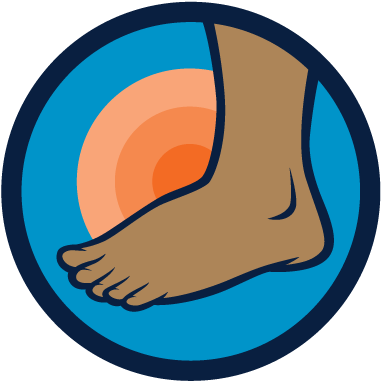STRESS FRACTURE
A stress fracture is a tiny crack in the bone caused by repeated impact or overuse. It’s common among runners, walkers who suddenly increase activity, athletes in sports with quick movements, and people with low bone density. With early treatment, most stress fractures heal well, allowing a safe return to activity. They often affect the foot and ankle, and diagnosis plus recovery time depend on the location and severity.

WHAT IS A STRESS FRACTURE?
A stress fracture happens when bone does not get enough time to recover between repeated loads. Instead of one big break, the bone develops a small crack in a high-stress area. In the foot and ankle, the most common foot stress fracture involves the metatarsals, especially the second and third. Other hot spots include the navicular, the heel bone, and the fibula near the ankle.
People often search for stress fractures feet or even type stretch fracture foot when they mean the same thing. No matter what you call it, the plan is similar: reduce stress on the bone so it can rebuild and then return slowly to activity.
SYMPTOMS YOU SHOULD NOT IGNORE
- A pinpoint spot on the foot or ankle that hurts when you press it
- Pain that increases with walking or running and eases with rest
- Swelling on top of the foot or along the outside of the ankle
- A change in your stride to avoid the sore area
- Symptoms that started after a recent jump in mileage, hills, or speed work
High-risk locations like the navicular or the base of the fifth metatarsal need early evaluation because they can take longer to heal.
WHEN IS IT TIME TO SEE A SPECIALIST
Seek an appointment if any of the following apply:
- You cannot walk a block without increasing pain
- Pain is still present after 7 to 10 days of rest and shoe changes
- The sore spot is in the midfoot or along the outer edge of the foot
- You have a history of stress fractures or low bone density
- You are unsure whether you have a sprain, tendon irritation, or a fracture
Early guidance prevents a small crack from becoming a complete break and shortens overall downtime.
COMMON CAUSES AND RISK FACTORS
- Sudden training changes: more miles, harder surfaces, new shoes
- Low vitamin D or calcium intake
- Low energy availability from dieting or missed meals
- Prior stress injury
- Poor foot mechanics such as very high or very flat arches
- Occupations with long hours on hard floors
If your soreness started after new shoes or a big training jump, step one is to scale back to pain-free levels while you get checked.
HOW WE DIAGNOSE A STRESS FRACTURE
A careful exam plus targeted imaging confirms the diagnosis and rules out sprains or tendon injuries.
- X-ray: Useful, but the first X-ray can be normal in the first 2 to 3 weeks. Follow-up films may show healing lines.
- MRI or CT: Finds stress injuries early and shows how advanced they are.
Your provider may also check vitamin D levels, footwear wear patterns, and training history to address root causes.
Foot & Ankle Physicians
WHY CHOOSE ORTHOARKANSAS
- Foot and ankle specialists: Fellowship-trained providers who treat stress injuries daily
- On-site imaging: Quick answers with X-ray and advanced imaging when needed
- Personalized return plans: Step-by-step guidance that fits your sport, job, and goals
- Root-cause focus: Gait check, shoe review, nutrition and bone health screening to reduce repeat injuries
You will leave with a clear plan, not a list of restrictions.
Frequently Asked Questions (FAQ)
Q: WHAT IS THE MOST COMMON FOOT STRESS FRACTURE?
Metatarsal stress fractures are most common, especially the second and third metatarsals.
Q: CAN I KEEP WALKING WITH A STRESS FRACTURE?
Short household walking in a stiff shoe or boot may be allowed, but long walks and running delay healing. Follow your provider’s load plan.
Q: MY X-RAY WAS NORMAL. COULD I STILL HAVE A STRESS FRACTURE?
Yes. Early X-rays can be normal. MRI or bone scan is more sensitive in the first weeks.
Q: HOW IS A FOOT ARCH STRESS FRACTURE TREATED? Usually with a boot or cast, protected weightbearing, and a slower return program. Some midfoot injuries need closer monitoring.
Q: HOW CAN I PREVENT ANOTHER STRESS FRACTURE? Increase training gradually, rotate shoes, add strength and balance work, and fuel with enough calories, protein, calcium, and vitamin D.
Q: WHAT SHOES ARE BEST WHILE I HEAL?
A stiff-soled walking shoe or rocker-bottom style reduces bending at the sore spot. Your clinician will advise when to transition back.
TAKE THE FIRST STEP TOWARD RELIEF
A short visit with a foot and ankle specialist can confirm your diagnosis, protect the bone while it heals, and build a safe path back to activity.







